FLORA AND GEORGE JACKMAN
Subject Name : Flora (b 1869 – d 1955) and George (b 1873 – d ?) Jackman
Researchers : Val Pink, Mike Brock
Did Flora and George Jackman, two children deserted on more than one occasion by their parents in the most appalling of circumstances, find a way of escaping from a future of desperate poverty?
Flora and George – Early Years
Flora Annie Jackman was born in the Guildford Union Workhouse on 30th July 1869, the second child of Jeremiah and Clio Catherine Jackman. Flora’s sister, named Clio Catherine after her mother, had been born the previous year. Their father Jeremiah was noted on Flora’s birth certificate as a brickmaker, but as a homemaker, his ability was questionable.
In February 1870, a few months after Flora was born, Jeremiah was charged with ‘leaving his wife & children chargeable to a Guildford Union’. The newspaper report on his trial said that Jerry, as he was also known, 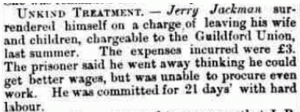 had left his family the previous summer, around the time of Flora’s birth. His plea was that ‘he went away thinking he could get better wages but was unable to procure even work’. He was charged and sent to Wandsworth Gaol for 21 days hard labour.
had left his family the previous summer, around the time of Flora’s birth. His plea was that ‘he went away thinking he could get better wages but was unable to procure even work’. He was charged and sent to Wandsworth Gaol for 21 days hard labour.
Jeremiah was nowhere to be seen at the time of the 1871 Census in April. His wife and two children were living with his mother-in-law Ann Luxon, a widowed 57-year-old, in Castle Street, Guildford. Jeremiah’s wife Clio Catherine was 23, Flora was a few months before her second birthday and sister Clio a year older. Another of Ann’s children, George Luxon, 16, was also living there. Both Ann and Clio senior were charwomen.
So where was Jeremiah? It is not known if he returned to the family home after his release from prison in March 1870, but in May 1871, he was again before the Guildford County 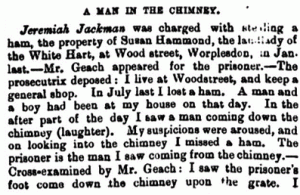 Bench, being charged with ‘feloniously stealing a ham in January of that year, the property of Susan Hammond, at Worplesdon’.
Bench, being charged with ‘feloniously stealing a ham in January of that year, the property of Susan Hammond, at Worplesdon’.
The West Surrey Times reported the trial at which Susan Hammond, landlady of the White Hart, caused laughter when she said that ‘I saw the prisoner’s foot come down the chimney upon the grate’. She later discovered a ham was missing, so two men from the White Hart pursued Jeremiah and his boy accomplice. This chase proved to be quite easy, as they had left footprints in the January snow. When Jeremiah was caught, a ham was found under his coat. He was found guilty and sentenced to four months hard labour in Wandsworth Gaol.
Jeremiah must have returned to his family at some stage as his third child, George, was born on 14th April 1873, in Meadrow, Godalming. Two years after that all three children were baptised together on 5th May 1875 at St Mary’s Church, Guildford. The address on the baptism was Castle Street, so this was likely to be the home of the children’s grandmother Ann, where C lio Catherine and her children had been living four years earlier.
lio Catherine and her children had been living four years earlier.
The following year another child was born, Grace Maud, on 9th October 1876 at the Guildford Union Workhouse. No father was named on her birth certificate which stated that Grace’s mother was ‘Catherine Jackman, formerly Freeland, servant domestic’. The workhouse birth record noted that Catherine was a widow. This intimates that Jeremiah was not the father, but he was certainly not dead either as Catherine’s mother claimed a few years later that she spoke to him.
Nevertheless, Catherine, about 37 years old, was now seemingly separated from her husband and had four children to care for – Clio, age 9, Flora (7), George (3) plus new-born Grace. Later records were to show that they were then in and out of the Guildford Union Workhouse for some time after Grace’s birth, but what was to follow was as shocking as it is almost hard to believe.
From Bad to Worse
On 16th February 1880, the children’s mother Catherine was apprehended on the London Road, about a mile and a half (2km) from Guildford, heading towards London with an unnamed man.
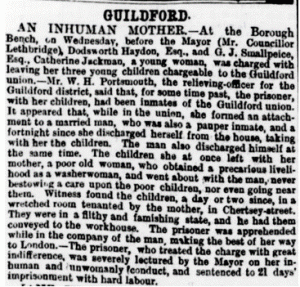 At the Guildford Bench session two days later, the full horror of what Catherine had done was revealed. Claiming that she was a widow, Catherine had abandoned her three youngest children – Flora, George and Grace – on her mother’s doorstep with the intention of ‘getting married…so the children should be taken off the rates’. The Bench heard that she had formed a relationship with a man in the Guildford Union Workhouse and that they went off together leaving her children behind.
At the Guildford Bench session two days later, the full horror of what Catherine had done was revealed. Claiming that she was a widow, Catherine had abandoned her three youngest children – Flora, George and Grace – on her mother’s doorstep with the intention of ‘getting married…so the children should be taken off the rates’. The Bench heard that she had formed a relationship with a man in the Guildford Union Workhouse and that they went off together leaving her children behind.
Mr Portsmouth, relieving officer for the Guildford Union, said that on seeing the children they were ‘in a filthy and famishing state’ and that the grandmother had no means of looking after them. He went on to say that Catherine did not have a home, that she had been in the workhouse since September 1879, and had previously ‘lived in and out of the house for a long time’. Her last home was in Woodbridge Hill, but she lived in such a state that he was ‘obliged to get them turned out under the Sanitary Act’.
Catherine denied having neglected her children. The Bench judged otherwise, noting that ‘in every respect her conduct was bad’, sentencing her to 21 days in prison.
Sadly, this was only the beginning. Less than three months later, on 8th May 1880, Catherine eloped again, with the same man as before now known to be widower William Hebburn. Once more, she left Flora, George and Grace, along with four of William’s children, on the doorstep of her mother Ann’s house in Chertsey Street, Guildford. Ann took her three youngest grandchildren plus William’s four children to the Guildford Union Workhouse, but this time there was to be no quick arrest of the errant parents by the police.
It was to be well over three years before Catherine and William were brought to justice which came about in somewhat strange circumstances. On 29th September 1883, police were called to a 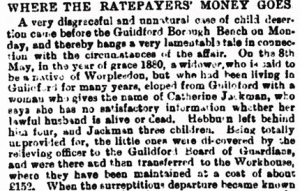 disturbance outside the house of Catherine’s mother in Guildford, where William was trying to wrestle a 15-month-old child out of the arms of Catherine. The child was believed to be the illegitimate offspring of the pair, and a large crowd gathered as William’s anger grew, seemingly wanting the child for himself. Eventually, the crowd, which included militiamen, tried to pull William away, who clung onto the child’s clothing by his teeth. When a policeman arrived, he recognised William as the man they had been looking for since the elopement, so he arrested him.
disturbance outside the house of Catherine’s mother in Guildford, where William was trying to wrestle a 15-month-old child out of the arms of Catherine. The child was believed to be the illegitimate offspring of the pair, and a large crowd gathered as William’s anger grew, seemingly wanting the child for himself. Eventually, the crowd, which included militiamen, tried to pull William away, who clung onto the child’s clothing by his teeth. When a policeman arrived, he recognised William as the man they had been looking for since the elopement, so he arrested him.
At the trial, the magistrates and Mayor said to Catherine and William that it was ‘… a most disgraceful case, leaving the children in the way you have done, and you will both be sent to prison with hard labour for three months’.
But what had become of Catherine and William’s children during their absence?
Catherine’s youngest child Grace died age just 4 from whooping cough in the Guildford Workhouse on 4th March 1881. Flora age 11 and George, 9, were Guildford Union scholars at the time of the Census in April 1881. At Catherine and William’s trial, it was revealed that their grandmother Ann had taken Flora and George out of the Workhouse when she laid in wait for them after school sometime after the Census. Their elder sister ’Kate’ (Clio Catherine), 13, was already living with their grandmother so all three children may have been back together again.
All four of William Hebburn’s children were scholars in the Workhouse in 1881. Read their story here “Abandoned children given new start in Canada”
In May 1884, Catherine gave birth to Edward Andrew Jackman at Old Barracks, North Street, Guildford, probably her mother’s home. No father’s name was given on the certificate.
Catherine’s child born two years earlier, the subject of her unsightly battle with William Hebburn, has remained a mystery. No record has been found for their child’s birth, which is perhaps not surprising as Catherine and William’s location at that time was unknown, and they were likely avoiding the authorities.
Flora was almost 15 when Edward Andrew was born. If she had remained in the Workhouse, she would have received training to go into domestic service. However, as she had been taken out of the Workhouse by her grandmother and probably not returned, her training most would have been curtailed.
Three years later on 12th October 1887 Flora gave birth to a daughter, Flora Annie Jackman, at the Guildford Union Workhouse. Mother Flora, 18, was noted as a ‘hawker of Stoke’. No father was named. At first glance, this would appear to be yet another unfortunate turn of events in her life, but happily, this was not the case.
By the 3rd January 1889, Flora had seemingly married, as on that day she gave birth to a son, Frederick John Brown, in Slough, Buckinghamshire (now Berkshire). The father was Edward John James Brown, a journeyman sweep. The birth certificate noted ‘Flora Annie Brown, formerly Jackman’ as the mother, although no official marriage record has been traced.
The 1891 Census shows the family settled in Upton-cum-Chalvey, Slough. Somewhat oddly, neither Flora and her three-year-old daughter Flora, nor her husband, were listed by their first names – Flora, age 26, and daughter, 3, were both ‘Annie’, while Edward, 32, was ‘John’ – the name he used for the rest of his life. This Census said that he was born in Reading, Berkshire, although later Censuses say he was born in Oxford – his origins have remained unclear. Frederick was 2 and he now had a brother, Francis, who was 2 months old.
But what of Flora’s brother George? It is possible that he was sent to Canada under the British Home Children scheme, in which orphaned or deserted children were given new homes with families in Canada, often employed as farm workers or domestics. A 13-year-old George Jackman travelled to Ontario on 31st March 1887 on the SS Circassian, but unfortunately, it has not been possible so far to prove that this George Jackman was Flora’s younger brother.
Other members of Flora and George’s family also remain untraced – their parents Jeremiah and Catherine, sibling Edward Andrew and the unnamed child that was at the centre of the family tug-of-war in 1883. The only other immediate member of the Jackman family, Flora and George’s elder sister Kate was, in 1891, a cook for the Rector of Storrington in Sussex. Two years later, she married William Ernest Greenfield, a groom. Kate went on to have a family with William in Bedhampton, Hampshire, but sadly in her early forties she entered the West Sussex County Asylum, Chichester in 1909 where she remained until her death in 1948.
As for Flora, she was now settled for probably the first time in her life. The 1901 Census showed her family had remained in Slough were now at 3 Chapel Street, a house with four rooms and a scullery, certainly far better accommodation than Flora would have experienced in much of her early life. She was now 35 and had five children – Flora, age 14, Frederick (12), Francis (10), Leonora (4) and Harold (7 months). Husband John was noted as 45, born in Oxford and still employed as a chimney sweep. Sadly, Flora and John had lost two children – Ada Eleanor in 1893 and Edward five years later, both under a year old.
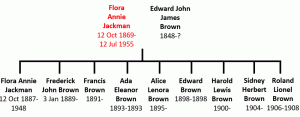 Flora and John had two more children – Sidney Herbert in 1904 and Roland Lionel, in 1906, although Roland passed away in 1908.
Flora and John had two more children – Sidney Herbert in 1904 and Roland Lionel, in 1906, although Roland passed away in 1908.
Their second son Francis had become a cause for concern as he appeared to be heading for a life of crime. At the age of just 11, he was caught with a 14-year-old accomplice on New Year’s Eve 1902 breaking into a shop and stealing money from the till. At the Slough Sessions a few days later, he admitted to this being the third time he had stolen money, so he was sentenced to receive ‘twelve strokes of the birch’. This was not his only appearance at the Slough Sessions that day, as Francis and his older brother Frederick were also fined the same day for the rather less serious offence of ‘playing cricket on highway’. In 1907, though, Francis was in more serious trouble when he was imprisoned for a month following two separate thefts which included stealing a revolver.
The 1911 Census showed the family had moved just around the corner in Slough to 17 Park Street, a house with five rooms. Flora, 42, was noted as having been married to John for 25 years, which would seem to indicate that her daughter Flora, born in 1887, had been fathered by him. John, 58, was now a self-employed ‘master chimney sweep’ with their second son, 16-year-old Francis, in the same business and seemingly no longer involved in the criminal world. Lenora, 14, was a clerk and a part-time student, Harold was 10 and Herbert 6. Flora and John’s eldest son Frederick had enlisted in the Royal Navy in 1907 and was serving onboard HMS Brilliant at this time, while daughter Flora was no longer living with them and was soon to marry Joseph Orton.
World War 1, as for so many families, was to cause heartbreak for Flora. Francis was killed in action on 16th August 1917 on the Western Front at Flanders, aged 26, while serving with the 2nd Battalion of the Princess Charlotte of Wales (Royal Berkshire) Regiment.
Son Frederick was more fortunate. He enlisted in the Royal Navy in 1907, and served throughout the Great War. After being demobilized in 1919, he was back serving with the Royal Navy two years later. The 1921 Census showed him as a single 32-year-old Able Seaman visiting his parents Flora and John, still at 17 Park Street. 52-year-old Flora’s occupation was listed as ‘home duties’ while John, despite being 70, remained a self-employed chimney sweep.
Flora’s husband John was last noted on the 1931 Electoral Roll at 17 Park Street, but no further record has been found to show what became of him. The 1939 Register, however, shows Flora to be a widow still at that address, age 70. Also living there was her son Frederick, a 50-year-old bachelor employed as a laboratory cleaner. He was an ‘RN Pensioner’, having been invalided out of the Royal Navy in May 1932 because of a duodenal ulcer.
Flora remained at 17 Park Street until in June 1955 she fell, fracturing her thigh. Now 87, she was admitted to the Royal Bucks Hospital in Aylesbury, but she was unable to recover, passing away on 12th July.
April 2021, updated January 2024
Sources
Ancestry.co.uk
BritishHomeChildren Registry.com
CanadianBritishHomeChildren.weebly.com
FindMyPast.co.uk / British Newspaper Archive
General Register Office GRO.gov.uk
Surrey History Centre, Woking Surreycc.gov.uk
The Charlotteville Jubilee Trust Ltd, Guildford, Surrey
For a full list of references click here.
